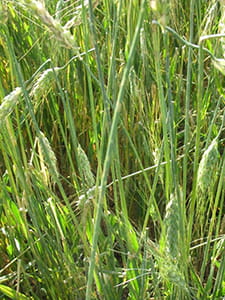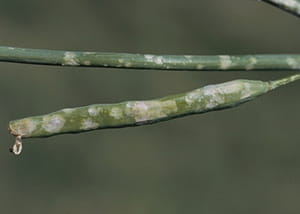By Tyce Masich, BSc, Crops Extension Specialist, Outlook
April 2024
Hail events are unpredictable and can occur anytime during the growing season with potentially devastating consequences on crop production. Severity of hail damage is dependent on crop type, variety, growth stage, hail intensity and area of the canopy affected by the hail. Hail damage causes yield losses to crops through stem breakage, defoliation, increased lodging, bacterial infections from open wounds and premature pod shattering.

Early season hailstorms tend to be less detrimental to crop yields. Crops such as wheat (prior to tillering), peas, lentils, faba beans and chickpeas have growth points below the soil surface in which damaged plants can regrow from; however, this will delay maturity. Canola seedlings are also resilient to hail as plants should survive if the growing point is intact. Crop regrowth can take time; therefore, it is important to scout the crop three to four days after a hailstorm to determine the surviving plant stand, prior to making reseeding decisions. Since early season hail typically isn’t devastating to yields and reseeding causes delayed maturity, reseeding usually isn’t economical unless hail results in very low or non-uniform plant stands. As crops mature, they have a lower probability of naturally recovering from hail damage which makes crops more susceptible to yield loss during mid-to-late crop stages.
Canola is more prone to significant yield loss after the seedling stage. When four to six leaf stage canola is hit with hail, the plant has less time to naturally recover and the damaged tissue makes the plant more susceptible to blackleg. Fungicides for blackleg in canola should only be applied if blackleg is an issue in your field and you were considering using them prior to the hailstorm. Hail after flowering will bruise the pods which results in seeds drying out and early shattering. If there is widespread bruising on the lower pods of canola plants, then consider early swathing (no earlier than 20 per cent colour change) to mitigate the risk of yield loss from pod shattering.
Hail damage between the milk and hard dough stage in wheat results in the greatest yield losses. In addition, simulated hail damage research shows that hail damage prior to the milk stage can greatly reduce yields depending on the storm's intensity and duration.

From Canola Council of Canada
Many varieties of peas, lentils, soybeans and faba beans have an indeterminate growth habit that maintains vegetative growth throughout the growing season which increases the chances of recovering from hail damage. However, hail damage to pods in pulse crops makes it easier for pathogens to enter and can result in poor seed set.
Unfortunately, response options for hail damage are limited. Research shows that using post-hail remedies such as fungicides and nutrient blends after a hailstorm has an insignificant impact on crop recovery and yield which usually makes these options uneconomical. Foliage damage and losses in crop canopy can promote weed activity; therefore, herbicide application may prevent further yield loss from weed pressure. However, to ensure safe and economical herbicide use, it is important to consider herbicide timing restrictions prior to harvest, estimated yield after hail damage and weed populations after hail damage. Purchasing hail insurance is the best option for protecting your crop investment from significant yield losses. For more information or if you have any questions about hail damage, please contact your local crops extension specialist or call the Agriculture Knowledge Centre at 1‑866‑457‑2377.
